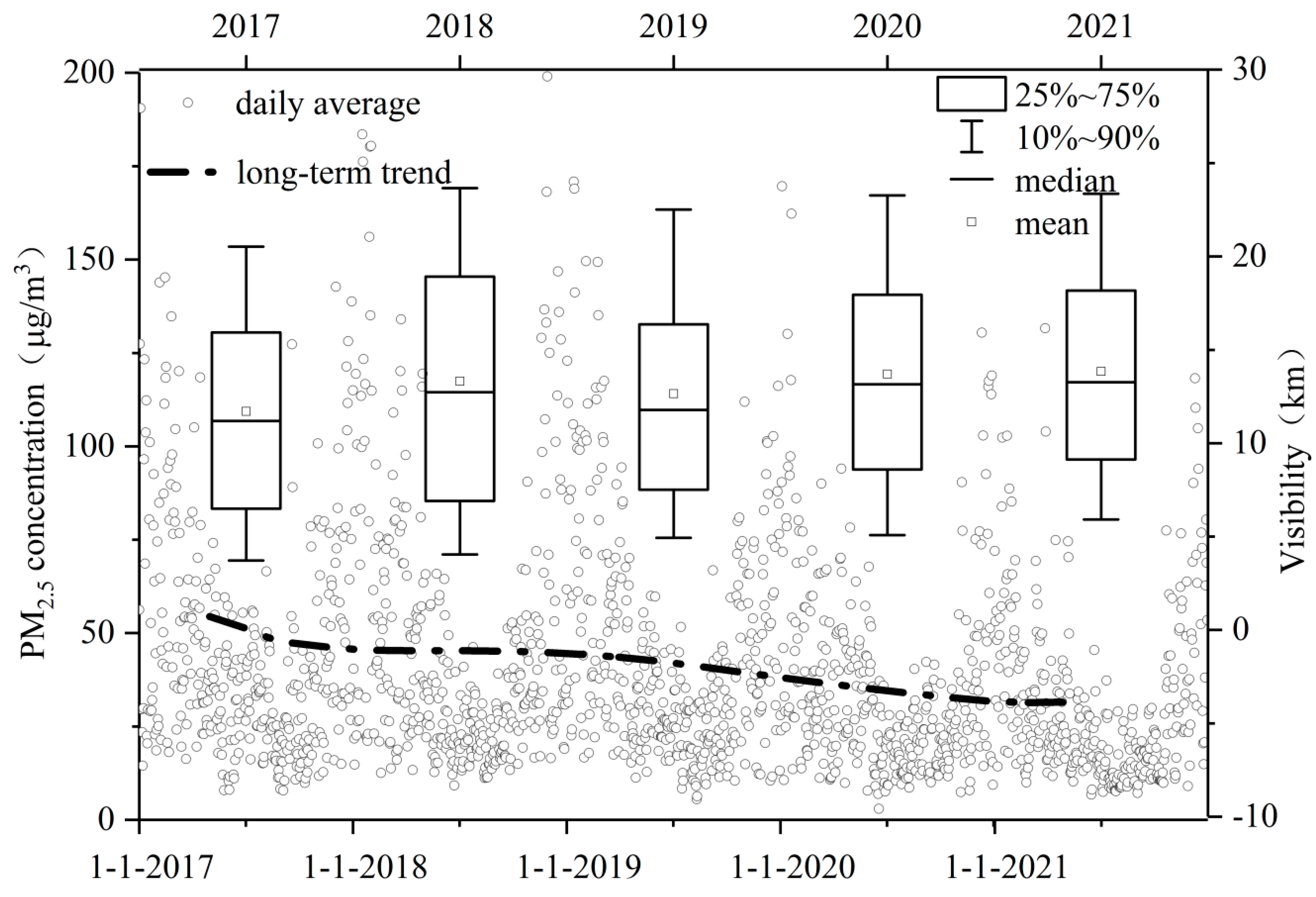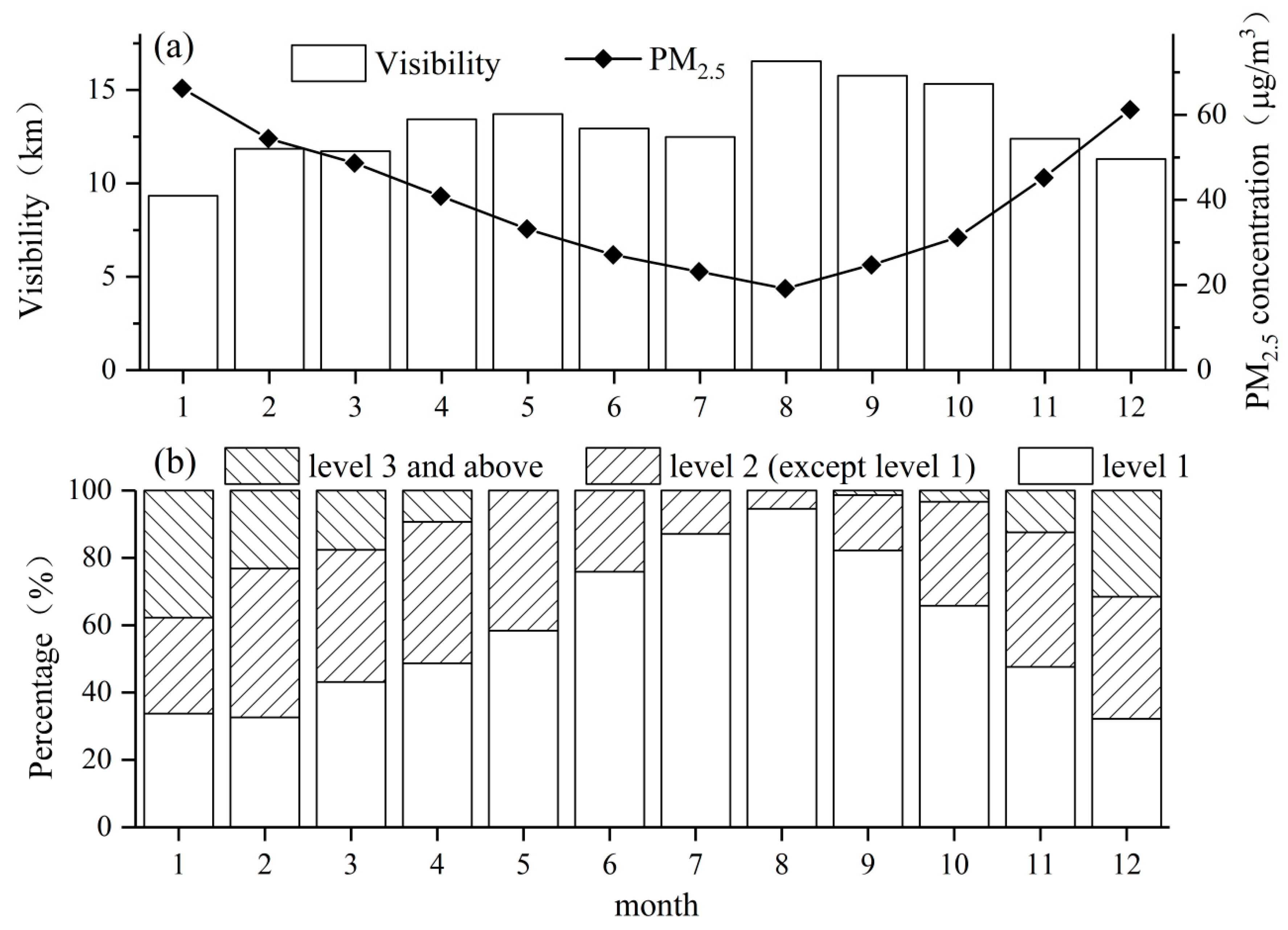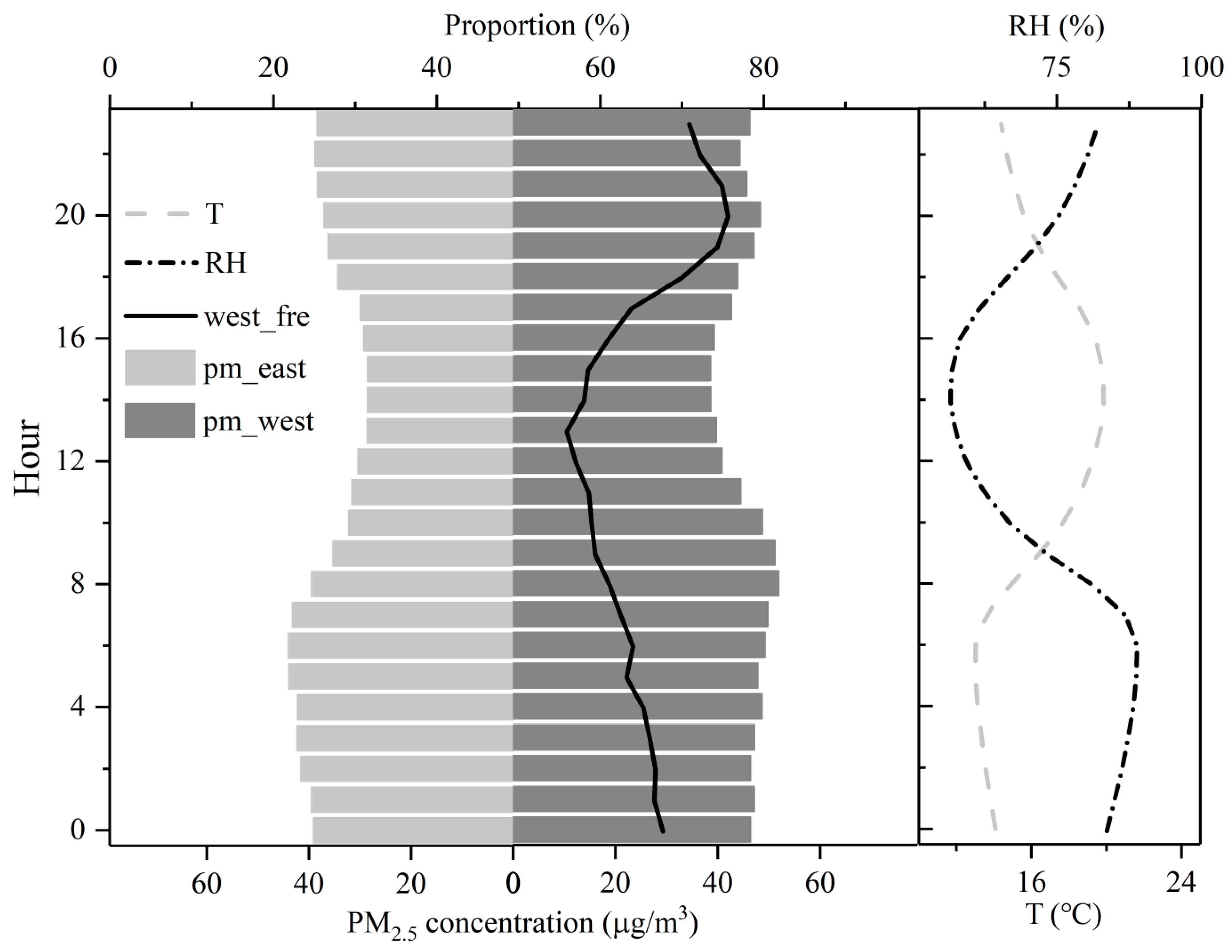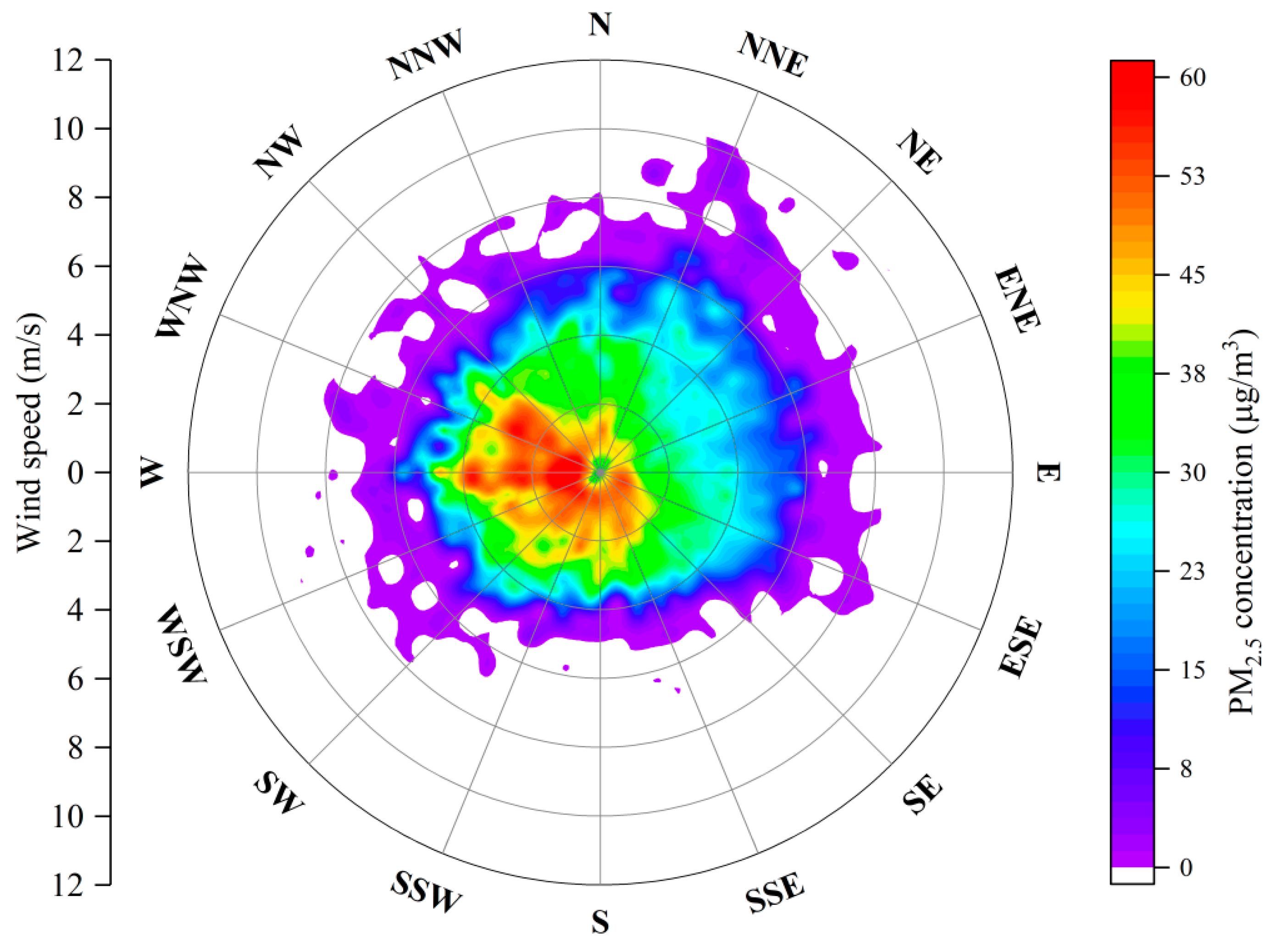Analysis of PM2.5 Characteristics in Yancheng from 2017 to 2021 Based on Kolmogorov–Zurbenko Filter and PSCF Model
Abstract
:1. Introduction
2. Data and Methods
2.1. Observation Site and Data
2.2. Kolmogorov–Zurbenko Filter
2.3. Potential Source Contribution Function (PSCF)
3. Results and Discussion
3.1. Time Variation of PM2.5 Mass Concentration
3.1.1. Annual Variation of PM2.5 Concentration
3.1.2. Monthly and Seasonal Variations of PM2.5
3.1.3. Diurnal Variations of PM2.5
3.2. Relationship between PM2.5 Concentration and Meteorological Elements
3.2.1. Correlation Analysis between PM2.5 Mass Concentration and Meteorological Elements
3.2.2. The Relationship between PM2.5 Concentration and Wind Direction and Wind Speed
3.2.3. The Relationship between PM2.5 Concentration and Visibility under Different Relative Humidity Conditions
3.2.4. Potential Source Contribution Function Analysis
4. Conclusions
Author Contributions
Funding
Institutional Review Board Statement
Informed Consent Statement
Data Availability Statement
Conflicts of Interest
References
- Liu, L.; Hu, F. Multi-attribute decision-based multi-objective optimization for regional atmospheric compound pollution control. Clim. Environ. Res. 2019, 24, 407–416. (In Chinese) [Google Scholar] [CrossRef]
- Feng, Y.; Huang, X.; Sun, H.; Liu, C.; Zhang, B.; Zhang, Z.; Tengur, V.S.; Chen, W.; Wu, T.; Yuan, J.; et al. Framingham risk score modifies the effect of PM10 on heart rate variability. Sci. Total Environ. 2015, 523, 146–151. [Google Scholar] [CrossRef] [PubMed]
- Deng, X.; Tie, X.; Wu, D.; Zhou, X.; Bi, X.; Tan, H.; Li, F.; Jiang, C. Long-term trend of visibility and its characterizations in the Pearl River Delta (PRD) region, China. Atmos. Environ. 2008, 42, 1424–1435. [Google Scholar] [CrossRef]
- Ma, Z.W.; Hu, X.F.; Sayer, A.M.; Levy, R.; Zhang, Q.; Xue, Y.; Tong, S.; Bi, J.; Huang, L.; Liu, Y. Satellite-based spatiotemporal trends in PM2.5 concentrations: China, 2004–2013. Environ. Health Perspect. 2016, 124, 184–192. [Google Scholar] [CrossRef] [PubMed]
- Hong, T.; Shakya, A.; Feng, W.; Wu, W.; Wei, L. Comparative ligandomic analysis of human lung epithelial cells exposed to PM2.5. Biomed. Environ. Sci. 2020, 33, 165–173. [Google Scholar]
- Hu, Z.M.; Wang, J.; Tao, Z.; Chen, Z. Pollution level and health risk assessment of heavy metals in PM2.5, Shanghai. Acta Sci. Circumstantiae 2013, 12, 3399–3406. [Google Scholar]
- Hou, X.; Zhu, B.; Kumar, K.R.; Lu, W. Inter-annual variability in fine particulate matter pollution over China during 2013–2018: Role of meteorology. Atmos. Environ. 2019, 214, 116842. [Google Scholar] [CrossRef]
- Huang, X.; Tang, G.; Zhang, J.; Liu, B.; Liu, C.; Zhang, J.; Cong, L.; Cheng, M.; Yan, G.; Gao, W.; et al. Characteristics of PM2.5 pollution in Beijing after the improvement of air quality. J. Environ. Sci. 2021, 100, 1–10. [Google Scholar] [CrossRef]
- Ji, D.; Yan, Y.; Wang, Z.; He, J.; Liu, B.; Sun, Y.; Gao, M.; Li, Y.; Cao, W.; Cui, Y.; et al. Two-year continuous measurements of carbonaceous aerosols in urban Beijing, China: Temporal variations, characteristics and source analyses. Chemosphere 2018, 200, 191–200. [Google Scholar] [CrossRef]
- Jacob, D.J.; Darrell, A.W. Effect of climate change on air quality. Atmos. Environ. 2009, 43, 51–63. [Google Scholar] [CrossRef]
- Zhang, R.H.; Li, Q.; Zhang, R.N. Meteorological conditions for the persistent severe fog and haze event over eastern China in January 2013. Sci. China Earth Sci. 2014, 57, 26–35. [Google Scholar] [CrossRef]
- Cheng, Y.F.; Hou, X.W.; Zhu, B.; Lu, W. The meteorological causes of a heavy pollution process in BTH and YRD area with stable weather condition. Acta Sci. Circumstantiae 2020, 40, 1575–1586. [Google Scholar]
- Chen, Y.N.; Luo, L.; Ma, H.; Jia, Y.; Zhao, J.; Xu, C.; Lou, X.; Yu, Y. Construction and application of stable weather index in Hangzhou. Acta Sci. Circumstantiae 2020, 12, 4461–4469. [Google Scholar]
- Zhang, H.D.; Lü, M.Y.; Zhang, B.H. Analysis of the stagnant meteorological situation and the transmission condition of continuous heavy pollution course from February 20 to 26, 2014 in Beijing-Tianjin-Hebei. Acta Sci. Circumstantiae 2016, 36, 4340–4351. [Google Scholar]
- Wang, Y.; Xuan, W.; Kondo, Y.; Kajino, M.; Munger, J.W.; Hao, J. Black carbon and its correlation with trace gases at a rural site in Beijing: Top-down constraints from ambient measurements on bottom-up emissions. J. Geophys. Res. Atmos. 2011, 116. [Google Scholar] [CrossRef]
- Wang, L.J.; Liu, X.H.; Lu, W.; Zhang, C.; Tang, W.Y.; Zhu, B. Impact of a cold front transport process on haze weather in eastern China in early winter. China Environ. Sci. 2021, 41, 2004–2013. [Google Scholar] [CrossRef]
- Wang, H.L.; Qiao, L.P.; Lou, S.R.; Zhou, M.; Ding, A.J.; Huang, H.Y.; Chen, J.M.; Wang, Q.; Tao, S.K.; Chen, C.H.; et al. Chemical composition of PM2.5 and meteorological impact among three years in urban Shanghai, China. J. Clean. Prod. 2016, 112, 1302–1311. [Google Scholar] [CrossRef]
- Rao, S.T.; Zurbenko, I.G.; Neagu, R.; Porter, P.S.; Ku, J.Y.; Henry, R.F. Space and Time Scales in Ambient Ozone Data. Bull. Am. Meteorol. Soc. 1997, 78, 2153–2166. [Google Scholar] [CrossRef]
- Kang, H.; Zhu, B.; de Leeuw, G.; Hou, C.; Gao, J. Natural and anthropogenic contributions to long-term variations of SO2, NO2, CO, and AOD over East China. Atmos. Res. 2018, 215, 284–293. [Google Scholar] [CrossRef]
- Jing, A.; Zhu, B.; Wang, H.; Yu, X.; An, J.; Kang, H. Source apportionment of black carbon in different seasons in the northern suburb of Nanjing, China. Atmos. Environ. 2019, 201, 190–200. [Google Scholar] [CrossRef]
- Liu, A.K.; Wang, H.L.; Cui, Y.; Shen, L.; Yin, Y.; Wu, Z.; Guo, S.; Shi, S.; Chen, K.; Zhu, B.; et al. Characteristics of Aerosol during a Severe Haze-Fog Episode in the Yangtze River Delta: Particle Size Distribution, Chemical Composition, and Optical Properties. Atmosphere 2020, 11, 56. [Google Scholar] [CrossRef]
- Cao, J.J.; Xu, B.Q.; He, J.Q.; Liu, X.-Q.; Han, Y.-M.; Wang, G.-H.; Zhu, C.-S. Concentrations, seasonal variations, and transport of carbonaceous aerosols at a remote Mountainous region in western China. Atmos. Environ. 2009, 43, 4444–4452. [Google Scholar] [CrossRef]
- Dai, M.; Zhu, B.; Fang, C.; Zhou, S.; Lu, W.; Zhao, D.; Ding, D.; Pan, C.; Liao, H. Long-Term Variation and Source Apportionment of Black Carbon at Mt. Waliguan, China. J. Geophys. Res. Atmos. 2021, 126, e2021JD035273. [Google Scholar] [CrossRef]
- Zhang, M. Numerical Study on Transport Characteristics of PM2.5 under Different Pollution Conditions in Beijing during Wintertime. Plateau Meteorol. 2022, 41, 829–838. [Google Scholar] [CrossRef]
- Wu, K.; Meng, Y.; Gong, Y.; Zhang, X.; Wu, L.; Ding, X.; Chen, X. Surveillance of long-term environmental elements and PM2.5 health risk assessment in Yangtze River Delta, China, from 2016 to 2020. Environ. Sci. Pollut. Res. 2022, 29, 81993–82005. [Google Scholar] [CrossRef] [PubMed]
- Yin, C.; He, J.; Yu, L.; Jiao, Y.; Zhou, L. The impact of multi-scale meteorological conditions on PM2.5 pollution over Ji’nan. Plateau Meteorol. 2019, 38, 1120–1128. [Google Scholar] [CrossRef]
- Lu, W.; Wang, H.L.; Zhu, B.; Shi, S.; Kang, H. Distribution characteristics of PM2.5 mass concentration and their impacting factors including meteorology and transmission in North Suburb of Nanjing during 2014 to 2016. Acta Sci. Circumstantiae 2019, 39, 1039–1048. [Google Scholar]
- Chen, L.W.A.; Doddridge, B.G.; Dickerson, R.R.; Chow, J.C.; Mueller, P.K.; Quinn, J.; Butler, W.A. Seasonal variations in elemental carbon aerosol, carbon monoxide and sulfur dioxide: Implications for sources. Geophys. Res. Lett. 2001, 28, 1711–1714. [Google Scholar] [CrossRef]
- Ji, D.; Li, L.; Pang, B.; Xue, P.; Wang, L.; Wu, Y.; Zhang, H.; Wang, Y. Characterization of black carbon in an urban-rural fringe area of Beijing. Environ. Pollut. 2017, 223, 524–534. [Google Scholar] [CrossRef]
- Dan, M.; Zhuang, G.; Li, X.; Tao, H.; Zhuang, Y. The characteristics of carbonaceous species and their sources in PM2.5 in Beijing. Atmos. Environ. 2004, 38, 3443–3452. [Google Scholar] [CrossRef]
- Arif, M.; Kumar, R.; Kumar, R.; Eric, Z.; Gourav, P. Ambient black carbon, PM2.5 and PM10 at Patna: Influence of anthropogenic emissions and brick kilns. Sci. Total Environ. 2018, 624, 1387–1400. [Google Scholar] [CrossRef] [PubMed]
- Cao, J.J.; Zhu, C.S.; Chow, J.C.; Watson, J.G.; Han, Y.-M.; Wang, G.-H.; Shen, Z.-X.; An, Z.-S. Black carbon relationships with emissions and meteorology in Xi’an, China. Atmos. Res. 2009, 94, 194–202. [Google Scholar] [CrossRef]
- Rajesh, T.A.; Ramachandran, S. Characteristics and source apportionment of black carbon aerosols over an urban site. Environ. Sci. Pollut. Res. Int. 2017, 24, 8411. [Google Scholar] [CrossRef] [PubMed]
- Trompetter, W.J.; Grange, S.K.; Davy, P.K.; Ancelet, T. Vertical and temporal variations of black carbon in New Zealand urban areas during winter. Atmos. Environ. 2013, 75, 179–187. [Google Scholar] [CrossRef]
- Wang, J.; Zhao, L.J. The characteristics of sea-land breeze circulation and the influence of ambient air quality in Xiamen. Environ. Sci. 2017, 42, 30–33. [Google Scholar]
- Boucouvala, D.; Bornstein, R. Analysis of transport patterns during an SCOS97-NARSTO episode. Atmos. Environ. 2003, 37, 73–94. [Google Scholar] [CrossRef]








| Season | VIS | T | RH | WS | |
|---|---|---|---|---|---|
| PM2.5 concentration | Spring | −0.52 ** | −0.09 ** | 0.01 ** | −0.23 ** |
| Summer | −0.47 ** | 0.03 | 0.01 | −0.27 ** | |
| Autumn | −0.52 ** | −0.30 ** | 0.20 ** | −0.26 ** | |
| Winter | −0.60 ** | 0.01 | 0.22 ** | −0.28 ** |
| RH | Fitting Equation | Correlation Coefficient | Threshold (ųg/m3) | Mean VIS (km) | Percentage (%) |
|---|---|---|---|---|---|
| RH ≤ 40% | Vis = 59.63x−0.32 | −0.78 | 265 | 21.33 | 6.90 |
| 40% < RH ≤ 60% | Vis = 63.57x−0.37 | −0.74 | 148 | 18.98 | 16.90 |
| 60% < RH ≤ 80% | Vis = 64.61x−0.44 | −0.64 | 69 | 15.52 | 29.83 |
| 80% < RH ≤ 90% | Vis = 50.56x−0.47 | −0.57 | 31 | 11.35 | 17.79 |
| RH > 90% | Vis = 22.72x−0.40 | −0.41 | 8 | 6.44 | 28.58 |
| Cluster | Percentage (%) | Passing Area | PM2.5 Concentration (ųg/m3) |
|---|---|---|---|
| 1 | 30.98 | Southwest Jiangsu, Southeast Anhui, northeast Zhejiang | 48.0 |
| 2 | 35.40 | Yellow Sea, Central Shandong, Tianjin, Beijing, northern Hebei | 42.9 |
| 3 | 33.62 | Yellow Sea | 29.3 |
Disclaimer/Publisher’s Note: The statements, opinions and data contained in all publications are solely those of the individual author(s) and contributor(s) and not of MDPI and/or the editor(s). MDPI and/or the editor(s) disclaim responsibility for any injury to people or property resulting from any ideas, methods, instructions or products referred to in the content. |
© 2023 by the authors. Licensee MDPI, Basel, Switzerland. This article is an open access article distributed under the terms and conditions of the Creative Commons Attribution (CC BY) license (https://creativecommons.org/licenses/by/4.0/).
Share and Cite
Dai, M.; Liu, A.; Sheng, Y.; Xian, Y.; Wang, H.; Wang, C. Analysis of PM2.5 Characteristics in Yancheng from 2017 to 2021 Based on Kolmogorov–Zurbenko Filter and PSCF Model. Atmosphere 2023, 14, 317. https://doi.org/10.3390/atmos14020317
Dai M, Liu A, Sheng Y, Xian Y, Wang H, Wang C. Analysis of PM2.5 Characteristics in Yancheng from 2017 to 2021 Based on Kolmogorov–Zurbenko Filter and PSCF Model. Atmosphere. 2023; 14(2):317. https://doi.org/10.3390/atmos14020317
Chicago/Turabian StyleDai, Mingming, Ankang Liu, Ye Sheng, Yue Xian, Honglei Wang, and Chanjuan Wang. 2023. "Analysis of PM2.5 Characteristics in Yancheng from 2017 to 2021 Based on Kolmogorov–Zurbenko Filter and PSCF Model" Atmosphere 14, no. 2: 317. https://doi.org/10.3390/atmos14020317






